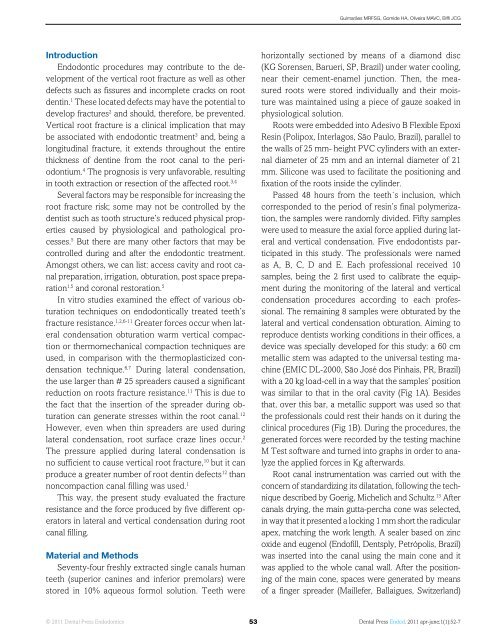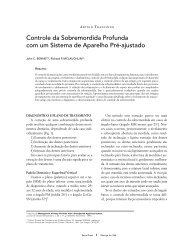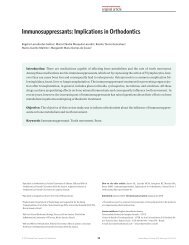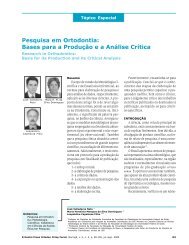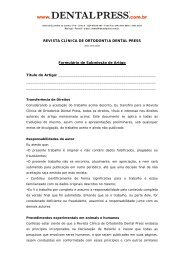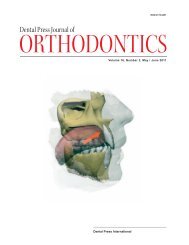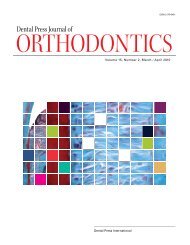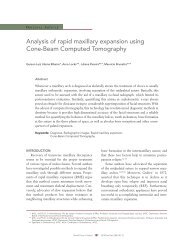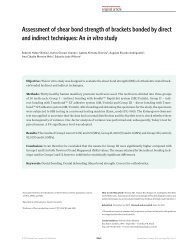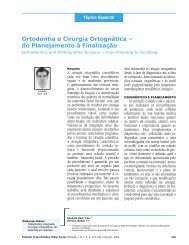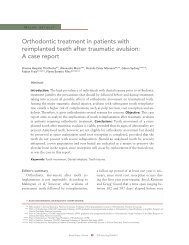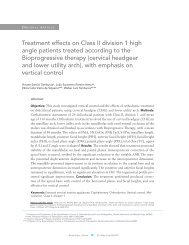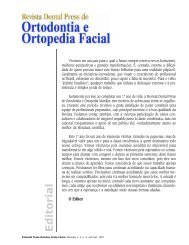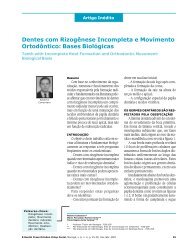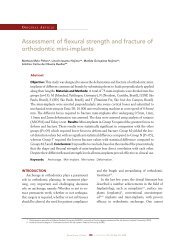Dental Press
Dental Press
Dental Press
You also want an ePaper? Increase the reach of your titles
YUMPU automatically turns print PDFs into web optimized ePapers that Google loves.
Guimarães MRFSG, Gomide HA, Oliveira MAVC, Biffi JCG<br />
Introduction<br />
Endodontic procedures may contribute to the development<br />
of the vertical root fracture as well as other<br />
defects such as fissures and incomplete cracks on root<br />
dentin. 1 These located defects may have the potential to<br />
develop fractures 2 and should, therefore, be prevented.<br />
Vertical root fracture is a clinical implication that may<br />
be associated with endodontic treatment 3 and, being a<br />
longitudinal fracture, it extends throughout the entire<br />
thickness of dentine from the root canal to the periodontium.<br />
4 The prognosis is very unfavorable, resulting<br />
in tooth extraction or resection of the affected root. 3,4<br />
Several factors may be responsible for increasing the<br />
root fracture risk; some may not be controlled by the<br />
dentist such as tooth structure’s reduced physical properties<br />
caused by physiological and pathological processes.<br />
5 But there are many other factors that may be<br />
controlled during and after the endodontic treatment.<br />
Amongst others, we can list: access cavity and root canal<br />
preparation, irrigation, obturation, post space preparation<br />
1,5 and coronal restoration. 5<br />
In vitro studies examined the effect of various obturation<br />
techniques on endodontically treated teeth’s<br />
fracture resistance. 1,2,6-11 Greater forces occur when lateral<br />
condensation obturation warm vertical compaction<br />
or thermomechanical compaction techniques are<br />
used, in comparison with the thermoplasticized condensation<br />
technique. 6,7 During lateral condensation,<br />
the use larger than # 25 spreaders caused a significant<br />
reduction on roots fracture resistance. 11 This is due to<br />
the fact that the insertion of the spreader during obturation<br />
can generate stresses within the root canal. 12<br />
However, even when thin spreaders are used during<br />
lateral condensation, root surface craze lines occur. 2<br />
The pressure applied during lateral condensation is<br />
no sufficient to cause vertical root fracture, 10 but it can<br />
produce a greater number of root dentin defects 12 than<br />
noncompaction canal filling was used. 1<br />
This way, the present study evaluated the fracture<br />
resistance and the force produced by five different operators<br />
in lateral and vertical condensation during root<br />
canal filling.<br />
Material and Methods<br />
Seventy-four freshly extracted single canals human<br />
teeth (superior canines and inferior premolars) were<br />
stored in 10% aqueous formol solution. Teeth were<br />
horizontally sectioned by means of a diamond disc<br />
(KG Sorensen, Barueri, SP, Brazil) under water cooling,<br />
near their cement-enamel junction. Then, the measured<br />
roots were stored individually and their moisture<br />
was maintained using a piece of gauze soaked in<br />
physiological solution.<br />
Roots were embedded into Adesivo B Flexible Epoxi<br />
Resin (Polipox, Interlagos, São Paulo, Brazil), parallel to<br />
the walls of 25 mm- height PVC cylinders with an external<br />
diameter of 25 mm and an internal diameter of 21<br />
mm. Silicone was used to facilitate the positioning and<br />
fixation of the roots inside the cylinder.<br />
Passed 48 hours from the teeth´s inclusion, which<br />
corresponded to the period of resin’s final polymerization,<br />
the samples were randomly divided. Fifty samples<br />
were used to measure the axial force applied during lateral<br />
and vertical condensation. Five endodontists participated<br />
in this study. The professionals were named<br />
as A, B, C, D and E. Each professional received 10<br />
samples, being the 2 first used to calibrate the equipment<br />
during the monitoring of the lateral and vertical<br />
condensation procedures according to each professional.<br />
The remaining 8 samples were obturated by the<br />
lateral and vertical condensation obturation. Aiming to<br />
reproduce dentists working conditions in their offices, a<br />
device was specially developed for this study: a 60 cm<br />
metallic stem was adapted to the universal testing machine<br />
(EMIC DL-2000, São José dos Pinhais, PR, Brazil)<br />
with a 20 kg load-cell in a way that the samples’ position<br />
was similar to that in the oral cavity (Fig 1A). Besides<br />
that, over this bar, a metallic support was used so that<br />
the professionals could rest their hands on it during the<br />
clinical procedures (Fig 1B). During the procedures, the<br />
generated forces were recorded by the testing machine<br />
M Test software and turned into graphs in order to analyze<br />
the applied forces in Kg afterwards.<br />
Root canal instrumentation was carried out with the<br />
concern of standardizing its dilatation, following the technique<br />
described by Goerig, Michelich and Schultz. 13 After<br />
canals drying, the main gutta-percha cone was selected,<br />
in way that it presented a locking 1 mm short the radicular<br />
apex, matching the work length. A sealer based on zinc<br />
oxide and eugenol (Endofill, Dentsply, Petrópolis, Brazil)<br />
was inserted into the canal using the main cone and it<br />
was applied to the whole canal wall. After the positioning<br />
of the main cone, spaces were generated by means<br />
of a finger spreader (Maillefer, Ballaigues, Switzerland)<br />
© 2011 <strong>Dental</strong> <strong>Press</strong> Endodontics 53 <strong>Dental</strong> <strong>Press</strong> Endod. 2011 apr-june;1(1):52-7


